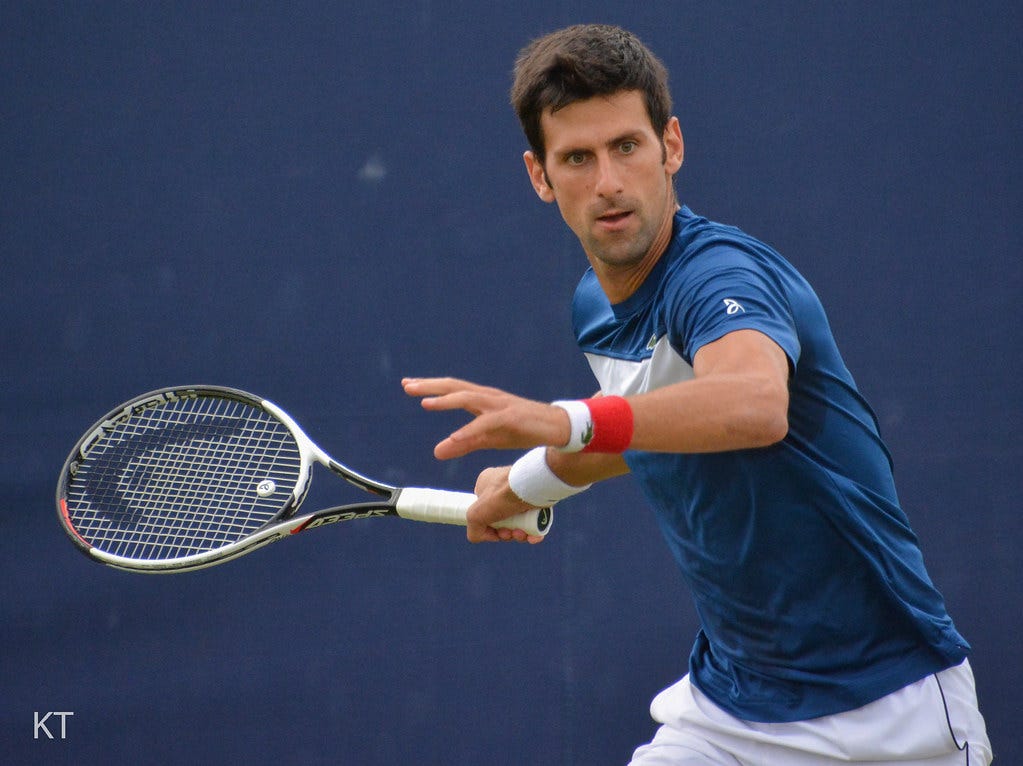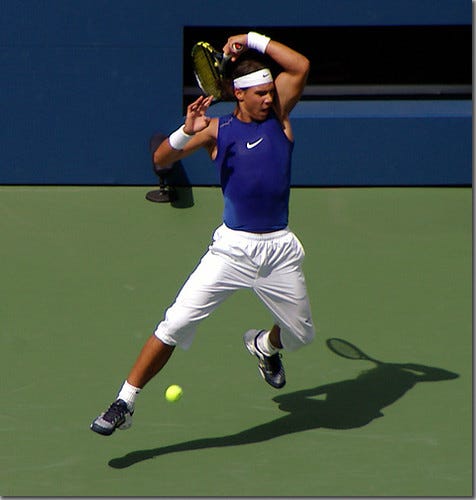“Winning breeds confidence and confidence breeds wins, just as losing breeds losses. This has an unfortunate circular ring to it, but without victories, real confidence is an unlikely occurrence.”
— Tennis: Winning the Mental Match, by Allen Fox

I recently came across a podcast episode with Jonah Oliver, an Australian sports psychologist who notably works with Cameron Smith, as well as a host of other professional athletes across motorsport, football, and tennis. Oliver’s background is in sport psychology and neuroscience, and his overall message to clients is simple:
“I try to help people focus on the right thing at the right time.”
Much of the talk centered around Oliver’s approach to clients that ask him to help with their confidence. An excerpt:
“It’s the most common thing I get asked to help with: “Jonah can you help me with my confidence”, “I’m struggling with no confidence”, or a coach will say, “Jonah, these guys aren’t confident enough” and it’s like this obsession with confidence, because the belief is, if I feel confident, I will play well. Whereas, what they're really saying is they want competence. Now, what’s the difference? Confidence is an emotion. I’m feeling a certain way, whereas competence is a behavior…In life and sport we’ve got to focus in bringing people’s competencies out, not searching for this idea that we have to be confident before that can happen. You know, confidence actually follows competence. Do you want a competent team or a confident team?”
Why do many of us think confidence can be cultivated on its own, in a vacuum separate and immune from real-world tests? While people may have varying degrees of trait confidence, I am yet to come across a player whose confidence doesn’t ebb and flow in concert with their results; confidence is a side-effect of competence. What we ought to be working on is the skillset required for the task; sport is about behavior. It’s about taking actions toward building competency. An excerpt from a prior piece on mentality:
…it’s easy to think that the best players are the ones who can simply control their Self 1 [emotions] better. While I think that probably explains some of it, it’s also possible that most players experience similar levels of doubt, nerves, and Self 1 talk, yet the player with a simpler game can manage Self 1 better. Better technique and athleticism may be more robust to Self 1’s sabotaging thoughts because better technique only contains the essence of a stroke…. they possess a degree of control in their game that helps them to play with Self 1….their game has a higher floor or ‘worst’ level.
The gist of that piece was about developing a degree of control in your game that allowed you to handle the mental challenge better. It’s not about reducing symptoms, it’s about building a capacity to play well even in the presence of nerves and doubts. It’s right in line with Oliver’s message. Another excerpt from the podcast:
“If you want to do hard things, there is a price of entry, and that might mean you feel some anxiety, some nerves, some pre-game uncertainty. Our brain hates uncertainty. It craves wanting to know…Humans would prefer the certainty of misery, than the misery of uncertainty. Acceptance? What does that mean? Learning that feeling tough internal experiences is normal, it’s okay, and it doesn't have any impact on my performance if I can just let it be there. So growing your capacity to actually sit with more discomfort. Not get rid of it.”
Part of the problem may be how we talk about sport—both in terms of performances and the psychological side of the game. Despite being games of action, often we talk about what we felt, rather than what we did. Another excerpt from the podcast:
“Even athletes and coaches get their language wrong. “Mate, you played really well out there today,” “Yeah yeah I was just super confident”. It’s like, the ball doesn’t know what you’re thinking and feeling? You swung the clubhead through the ball square. You behaved competently, but then we used the wrong language and say we were really confident, and then we unintentionally go searching for it again and again because we think the reason we played well was because we felt confident, versus, we displayed competent behaviours. If I can just connect to my competence and let go of my attachment to needing to feel confident, then I’m much more likely to be consistent…and all of a sudden I build up a pattern of behaviour and some form because I’m behaving competently and consistently whilst being emotionally normal and human, which means highly varied at times, and that doesn’t matter.”
Metaphors We Live By
Metaphors We Live By is a book by George Lakoff and Mark Johnson. A quote from the opening page:
“Metaphor is for most people a device of the poetic imagination and the rhetorical flourish—a matter of extraordinary rather than ordinary language. Moreover, metaphor is typically viewed as characteristic of language alone, a matter of words rather than thought or action. For this reason, most people think they can get along without metaphor. We have found, on the contrary, that metaphor is pervasive in everyday life, not just in language but in thought and action. Our ordinary conceptual system, in terms of which we both think and act, is fundamentally metaphorical in nature.”
Two examples from the book regarding metaphors for the mind:
The book outlines in great detail and clarity how much of our entire understanding of the world is built upon layers of metaphors:
“Because so many of the concepts that are important to us are either abstract or not clearly delineated in our experience (the emotions, ideas, time, etc.), we need to get a grasp on them by means of other concepts that we understand in clearer terms (spatial orientations, objects, etc.).” p. 115
Psychology especially has depended on metaphor as a means to gain a degree of understanding about our minds. Different metaphors allow us to focus on different aspects of a concept (as the above examples show). This produces new meanings of a concept which can shape how we end up behaving as well.1 I've touched on "biomechanical metaphors" in a prior piece on motor learning, and how they show evidence for superior skill execution in novices without having explicit knowledge of the skill.2
“new metaphors have the power to create a new reality. This can begin to happen when we start to comprehend our experience in terms of a metaphor, and it becomes a deeper reality when we begin to act in terms of it.”
— Metaphors We Live By p. 145
Acceptance and Commitment Therapy
Oliver’s approach was influenced after he retrained in Acceptance and Commitment Therapy (ACT). An excerpt from a summary on ACT:
Clients learn to stop avoiding, denying, and struggling with their inner emotions and, instead, accept that these deeper feelings are appropriate responses to certain situations that should not prevent them from moving forward in their lives. With this understanding, clients begin to accept their hardships and commit to making necessary changes in their behavior, regardless of what is going on in their lives and how they feel about it.

What is interesting is how ACT uses metaphor to help clients seperate themselves from their thoughts. An excerpt from the British Psychological Society :
When the focus turns to disordered minds, traditional metaphors undergo some interesting adaptations. Many modern examples of cognitive therapy, such as acceptance and commitment therapy (ACT), depend on clients being able to separate out troublesome thoughts from the container of the self. A striking twist on the metaphor comes from seeing the mind as an infinite chessboard, upon which the client imagines negative thoughts (black pieces) fighting positive ones (white pieces). After saying where they think they themselves are positioned on the board, clients are told they are none of the pieces, but the chessboard itself. The result can be an effective way of distancing sufferers from the source of their distress.
Coming up with a metaphor doesn’t automatically mean you will believe it, obviously. But I think the important take away here is to be aware that how you think of something, and how you define it, affects how you act, and how you percieve what is in your power. If you think of the mind as a muscle, then you might think you can train it with exercises. If you think of it as a brittle machine, you might think it hopeless to do anything. Ultimately, no matter what you think, to get better at this game (and most things) is still about taking action. Identify where you need to improve your skillset, and set to work on that with purpose.
Tiger Woods, undoubtedly on the Mount Rushmore of mental giants in all of sport, echoes a similar sentiment/mental framework to ACT (and Nadal) in the clip below:
An excerpt:
~6:15 “It’s okay to feel uncomfortable. I’ve been asked this question numerous times, “Am I ever nervous?…Are you kidding me? I’m nervous on the very first shot, I’m nervous throughout the entire day. but it’s how I channel it, and how I harness it. How do I put that energy into either deeper focus or deeper intensity? And that’s something we can all do. And it’s not being ashamed or afraid of it. Go after it.”
We can talk about Tiger’s mental strength all day, but what interests me is that his drive to improve never stopped even when he reached the pinnacle. He made deliberate (painful and surely frustrating) changes to his swing after he was already world number 1 and dominating.
~8:32 - “I felt like I couldn’t be in contention every time I teed it up with the swing I used to have. I felt that I was not hitting it in the right direction for the long haul…I think the main thing in those changes I’ve made is I’ve become more of a consistent player. My bad shots aren’t that bad, and my good shots are always going to be pretty good, but it’s the bad ones that are the key to shooting good solid numbers.”
None of this is new. William James, in the “muscular mood of his day” echoed a similar sentiment over 100 years ago3:
“There is no more contemptible type of human character than that of the nervous sentimentalist and dreamer, who spends his life in a weltering sea of sensibility and emotion, but who never does a manly concrete deed.”
The cultural meanings of certain concepts also play an important role in how a metaphor will be interpreted.
E.g., researchers in China instructed novice table tennis players to ‘hit up the hypotenuse of a right-angled triangle’ to teach them the topspin forehand. Participants who were instructed with this metaphor performed better than explicitly taught participants.
Habits of the Heart: Individualism and Commitment in American Life, p. 120




